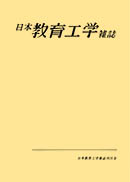Volume 24, Issue 1
Displaying 1-15 of 15 articles from this issue
- |<
- <
- 1
- >
- >|
-
Article type: Cover
2000 Volume 24 Issue 1 Pages Cover1-
Published: June 20, 2000
Released on J-STAGE: October 20, 2017
Download PDF (35K) -
Article type: Cover
2000 Volume 24 Issue 1 Pages Cover2-
Published: June 20, 2000
Released on J-STAGE: October 20, 2017
Download PDF (35K) -
Article type: Appendix
2000 Volume 24 Issue 1 Pages App1-
Published: June 20, 2000
Released on J-STAGE: October 20, 2017
Download PDF (22K) -
Article type: Article
2000 Volume 24 Issue 1 Pages 1-2
Published: June 20, 2000
Released on J-STAGE: October 20, 2017
Download PDF (208K) -
Article type: Article
2000 Volume 24 Issue 1 Pages 3-13
Published: June 20, 2000
Released on J-STAGE: October 20, 2017
Download PDF (1327K) -
Article type: Article
2000 Volume 24 Issue 1 Pages 15-23
Published: June 20, 2000
Released on J-STAGE: October 20, 2017
Download PDF (1197K) -
Article type: Article
2000 Volume 24 Issue 1 Pages 35-52
Published: June 20, 2000
Released on J-STAGE: October 20, 2017
Download PDF (1729K) -
Article type: Article
2000 Volume 24 Issue 1 Pages 53-62
Published: June 20, 2000
Released on J-STAGE: October 20, 2017
Download PDF (938K) -
Article type: Article
2000 Volume 24 Issue 1 Pages 63-72
Published: June 20, 2000
Released on J-STAGE: October 20, 2017
Download PDF (1084K) -
Article type: Article
2000 Volume 24 Issue 1 Pages 93-98
Published: June 20, 2000
Released on J-STAGE: October 20, 2017
Download PDF (999K) -
Article type: Appendix
2000 Volume 24 Issue 1 Pages App2-
Published: June 20, 2000
Released on J-STAGE: October 20, 2017
Download PDF (16K) -
Article type: Appendix
2000 Volume 24 Issue 1 Pages App3-
Published: June 20, 2000
Released on J-STAGE: October 20, 2017
Download PDF (88K) -
Article type: Appendix
2000 Volume 24 Issue 1 Pages App4-
Published: June 20, 2000
Released on J-STAGE: October 20, 2017
Download PDF (101K) -
Article type: Cover
2000 Volume 24 Issue 1 Pages Cover3-
Published: June 20, 2000
Released on J-STAGE: October 20, 2017
Download PDF (41K) -
Article type: Cover
2000 Volume 24 Issue 1 Pages Cover4-
Published: June 20, 2000
Released on J-STAGE: October 20, 2017
Download PDF (41K)
- |<
- <
- 1
- >
- >|
